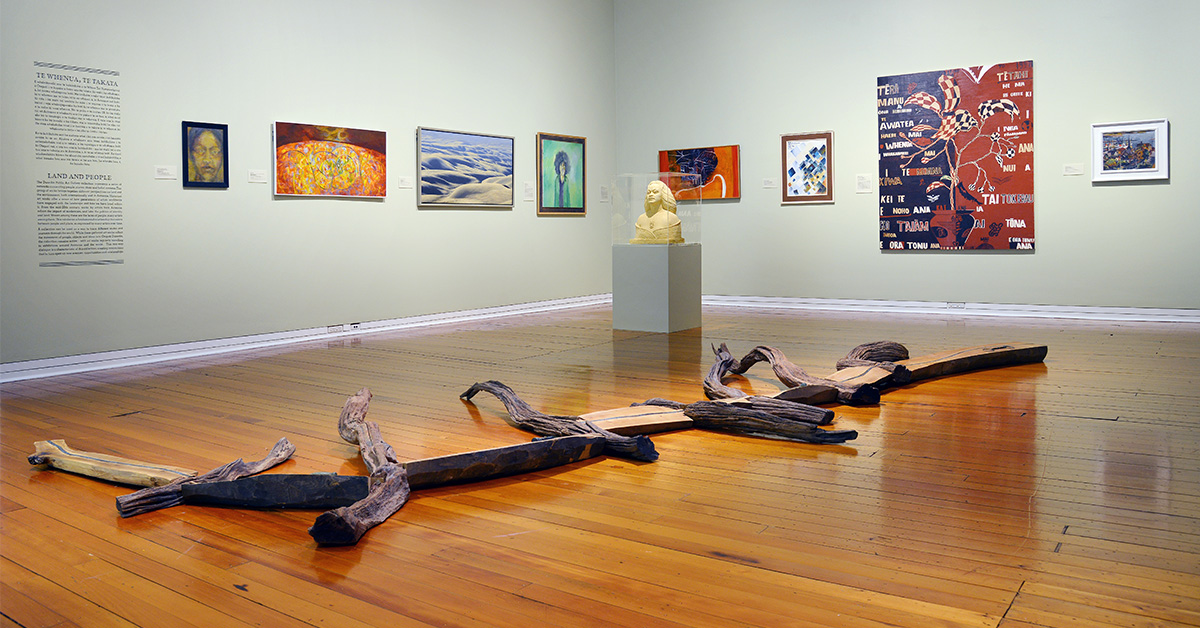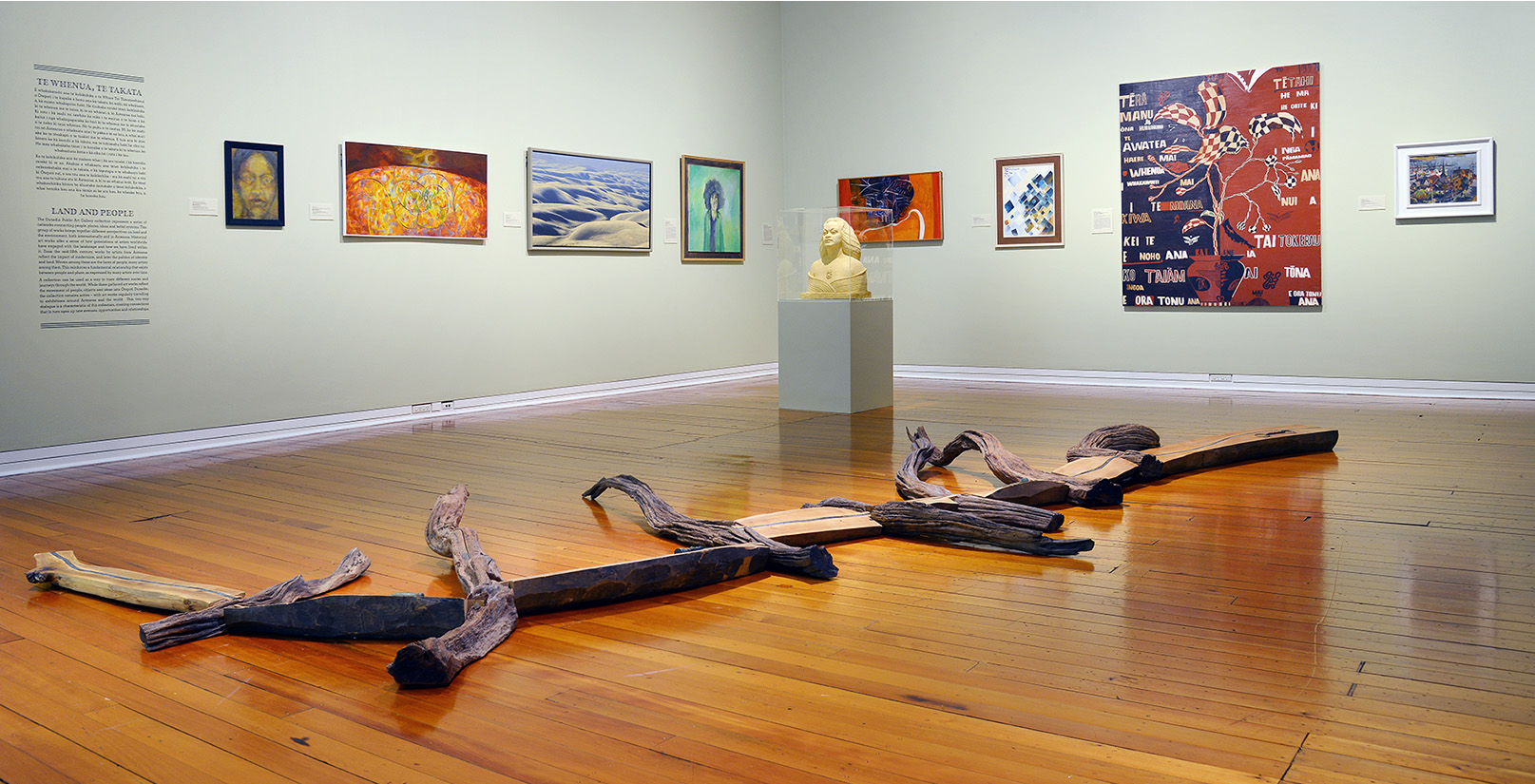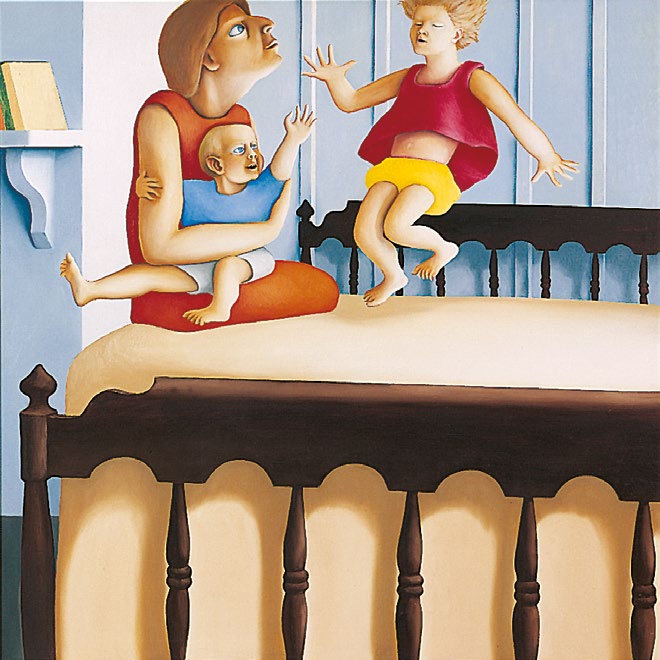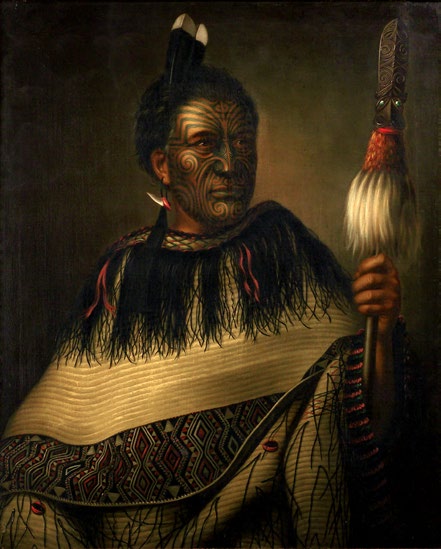
Culture Etc.

Above: Peter Nicholls, River Crossings 1990 (Installation shot). Given in 2019 by the artist.
The Art of Giving
Where do our galleries’ collections come from? The journey of an artwork from a private owner to the gallery wall can be as fascinating as the work of art itself, as the Dunedin Public Art Gallery’s collection shows.
By Thomas McLean
We don’t know much about Hazel Maban Bell, but we owe her our gratitude. Miss Bell was born in West Taieri and graduated from Dunedin Teachers’ College in 1922. She died in Nelson in 1975, aged 76. In her will she asked that her house and all but one of her belongings be sold and the profits given to children’s charities. The only item not sold was a chest carved from rimu with pāua shell inlay. This one cherished item she bequeathed to the Dunedin Public Art Gallery.
One wonders what then-director Les Lloyd and the gallery council made of the donation. Perhaps they were thrilled with the bequest. But one suspects that at least a few of the councillors found the gift more curiosity than work of art.
The chest has been displayed occasionally, but it received renewed interest last year, when careful study identified its previously unknown creator as Wihau Te Raihi (1886–1951), a gifted Te Arawa carver. It was probably made in the 1940s. Te Raihi’s chest now helps the gallery tell the story of the remarkable renaissance of Māori arts in the 20th century.
The chest features prominently in Hurahia ana kā Whetū: Unveiling the Stars (on until 30 October 2022), a dramatic rehang of the permanent collection undertaken by gallery curators working with Paemanu, a Ngāi Tahu art collective. Eschewing chronological presentation, the exhibition presents surprising and often provocative juxtapositions across time and place, highlighting works by Māori, Pacific and female Pākehā artists that have rarely been shown before.
But how did these works end up on the gallery’s walls at all? In many cases, they were a gift — sometimes grand and transformative; other times they simply sit in storage, waiting for their moment.
Wander through almost any public gallery, noting the donors’ credit lines, and a handful of names will almost certainly appear again and again. At the Dunedin Public Art Gallery (DPAG), those names include Brasch, Monheimer and de Beer. We inevitably think of Dunedin as a Scottish stronghold, but many of its most prominent 20th-century donors belonged to the city’s Jewish community.
Though born in Dunedin, Mary, Dora and Esmond de Beer spent most of their adult lives in England, where Esmond (1895–1990) was an important scholar of 17th-century British writing. But the de Beers retained an affection for Dunedin. As Esmond wrote, “My sisters and I have always thought of Dunedin as our ‘home’, our essential background, and have wanted to do what we could towards the furtherance of its learning and culture.”
Do we need another reason to like Sam Neill? In 2000, the actor donated Michael Smither’s 1969 portrait of rambunctious childhood, Harry, Thomas and Sarah, in memory of his mother Priscilla.

Michael Duncan Smither, Harry, Thomas and Sarah 1969. Gift of Sam Neill, in memory of his mother Priscilla Neill.
The de Beers bestowed more than 170 works upon DPAG (they were equally generous to the University of Otago’s libraries). Gallery director Cam McCracken calls the donation “astounding”. Many of these works, like Zanobi Machiavelli’s Madonna and Child (1452–53) — one of the few masterworks in New Zealand from the Florentine Renaissance — and Claude Monet’s La Débâcle (1880), have become cornerstones of the collection and would create envy in almost any curator.
The donation, most of which was given in 1982, included a significant group of Japanese woodcut prints — a special interest of Dora de Beer. To those who have, more shall be given, saith the scriptures; or, as gallery curator Lucy Hammonds puts it, “A quality collection attracts interest and surprise.” DPAG’s Japanese woodcut collection, already remarkable, became even more impressive in 1993, when Andrew Munro gifted his father’s collection of a nearly complete set of Hokusai’s Thirty-six Views of Mount Fuji.
Some gifts commemorate a friend or family member who has passed away. In the 1920s, the philanthropists Percy and Lucy Sargood purchased a building in Logan Park that would house the Dunedin Public Art Gallery for 70 years, in memory of their son Rolfe, who had died at Gallipoli.
Our galleries also preserve smaller acts of remembrance, and profound stories arise from just a few words in a credit line. Hurahia ana kā Whetū includes Gottfried Lindauer’s dignified if slightly stiff portrait of the rangatira Ngairo Rakaihikuroa holding a taiaha. But our experience of the painting is deepened, and perhaps complicated, when we read that it was donated by “Mr. J.S. Hyslop, in memory of Ninian Steel Hyslop, 2nd Lieutenant RFC, killed in action Mesopotamia, 1917, whence DPAG by gift, 1924”. A grieving younger brother, whose sibling lies buried in Basra War Cemetery (today in Iraq), finds another way to memorialise his brother’s sacrifice and his family’s loss.
Not all memorial gifts are quite so melancholy. Do we need another reason to like Sam Neill? In 2000, the actor donated Michael Smither’s 1969 portrait of rambunctious childhood, Harry, Thomas and Sarah. When on display, the painting’s accompanying label reads, “Gift of Sam Neill, in memory of his mother Priscilla Neill (1914–1999), who loved this collection.” Neill says it reminded him of all the sacrifices his mother had made. “There was something about the mother in the picture, and her long suffering love for her children, that touched me.” Earlier, in 1988, Neill had donated three stunning photographs by Laurence Aberhart, proving that he has long had a good eye.

Gottfried Lindauer, Chief Ngairo Rakaihikuroa in Wairarapa, New Zealand. Given in 1924 by JS Hyslop in memory of his brother killed in World War II.
“Gift of the artist” appears on a surprising number of labels in New Zealand’s galleries. “Often gifts will accompany purchases,” Cam McCracken says. “It’s often a combination of generosity from the dealer and the artist.” An artist might donate a work’s preliminary sketches, or a related piece. But sometimes it’s about an artist finding the right permanent home for their creation.
In 1996, the leading American artist Robert Rauschenberg gave DPAG “Tribute 21”, a portfolio of 22 large colour lithographs celebrating leaders and their areas of achievement (Carl Sagan for space, Toni Morrison for literature, Mikhail Gorbachev for peace). The gallery was one of 21 museums worldwide (among them the British Museum, MoMA and the Hermitage) selected “on the basis of social impact” to receive the works. It’s rare to see a major contemporary American artist in New Zealand, and these lithographs — seven are currently on view — stop art majors in their tracks.
Closer to home, the sculptor Peter Nicholls donated his River Crossings (1990) to DPAG in 2019, just two years before his death. Made from elm and southern rātā — one introduced, the other native — River Crossings celebrates the waterways that shape our islands, while also commenting on the ecological effects of human actions. In the current exhibition, it snakes along the gallery floor, shaping our experience of the large room in which it appears. “Peter was always thrilled when a gallery purchased or accepted his works,” his widow Stephanie Bate told me. “It meant it’s going to be looked after and enjoyed.”
Imagine donating a special work of art after visiting an art gallery overseas. Switzerland-based collectors Ivor Trevena Idris and Richard Deeble visited DPAG and thought it could use some quality Dutch painting. In 2003 they donated a nautical scene by the important 17th-century artist Jan van Goyen and a terrific image of men tending livestock as a storm blows in by the 18th-century painter Michiel Versteeg.
Now, imagine donating a special work of art after reading about a gallery. Edi Allshouse, a descendant of the American artist John James Audubon, had never visited DPAG, but she read an article describing how its early supporters had spent their savings to acquire Petrus van der Velden’s sublime Waterfall in the Otira Gorge (1891). Impressed that a young gallery would go all-in for a local masterwork, Allshouse contacted the gallery and eventually donated 15 works, including a striking Audubon aquatint of that controversial Dunedin resident, the cormorant.
“One of my curatorial challenges,” says Lucy Hammonds, “is to make sure that there is always a work or some works that are having their debut.” Hurahia ana kā Whetū includes the moody watercolour Karitane, Otago painted by Elizabeth Friberg in 1920. It was bequeathed in 1974 by Mrs Winifred Isabel Cameron — apparently her only donation to the gallery. After 48 years, it is being shown for the first time.
This may seem extraordinary — most of today’s New Zealanders hadn’t been born when this image entered the collection. But galleries have limited space. DPAG holds over 8000 items, and only a few hundred can be displayed at once. Works created on paper, especially watercolours, are delicate objects that fade when exposed to regular light. And perhaps some artworks must await their moment: we are far more interested in women artists today than we were in the 1970s.
“We’ve been here for 140-odd years,” says McCracken, “and the aim is to be here in perpetuity. And so while something might not see the light of day for maybe 40 or 50 years, I’m at peace with that.”
One piece, donated
in 1974, is only now being shown for the first time. This may seem extraordinary — most of today’s New Zealanders hadn’t been born when this image entered the collection — but galleries have limited space.

Elizabeth Friberg, Karitane, Otago 1920. Bequeathed in 1974 by Winifred Isabel Cameron.
As storage space dwindles and insurance costs rise, the era of the transformational gift may be ending. “There’s only so much space,” says McCracken. “There’s only so much resource. And so there is a very judicious approach towards adding to the collection.” Important bequests and donations continue, but another approach is taking hold: guardianship rather than ownership.
Since the 1990s, Wellington collectors Jim and Mary Barr have placed a large part of their contemporary New Zealand art collection on long-term loan at DPAG. As a result, visitors experience a varied and changing range of recent work that might otherwise be unaffordable to the gallery.
In 2014, the gallery and the Gordon Walters estate developed a partnership whereby the estate transferred a collection of artworks and supporting research material to the gallery. While not a permanent gift, the gallery is able to draw on the estate’s diverse collection. The major touring exhibition Gordon Walters: New Vision and its accompanying catalogue were two significant results.
More recently, DPAG has come to an understanding with the Paemanu Charitable Trust to look after a collection of works from contemporary and future Ngāi Tahu artists. “It’s a collection that will grow over time,” says McCracken. This agreement has already resulted in the daring rehang of the permanent collection, as well as an expansive exhibition of new Ngāi Tahu works, Tauraka Toi: A Landing Place (on until the end of April). Further collaborations are planned. In their own ways, each of these agreements is as transformational to the gallery as the gifts of the Sargoods or the de Beers.
When I moved to Dunedin from the United States, I visited the gallery almost every weekend: it was my lifeline to the wider world of arts. I became a member of the DPAG Society, then an executive committee member and, for one year, society president (the roles were volunteer positions and I am no longer formally associated with the gallery). But I have never donated a work of art.
Recently I offered DPAG a 1930s woodcut print made by a New Zealand-born artist. Before making the offer, I did some homework. The artist has a Dunedin connection, and the gallery holds other works by him. Another significant consideration: Christchurch Art Gallery Te Puna o Waiwhetū does not own the piece (Christchurch and Dunedin often share works, so no need to double up). The gallery asked for images, to ascertain the condition of the work, and about provenance. The next step will be for a curator to examine the work in person. If the print is deemed appropriate, the gallery will develop a proposal explaining why it should enter the permanent collections.
Inevitably, even this straightforward and respectful process has left me feeling a little exposed. What if my print is a fake, or its condition isn’t as fine as I thought it was? If they decline it, will I feel rejected? If they accept it, do I really want my name associated with it? And what if it remains in storage for 50 years? I always knew that it requires generosity and a little bit of pride to donate art. This experiment has already taught me that it also requires patience, trust, and perhaps some bravery too.
All artworks part of the Dunedin Public Art Gallery collection.
Thomas McLean teaches English at the University of Otago.
This story appeared in the May 2022 issue of North & South.
